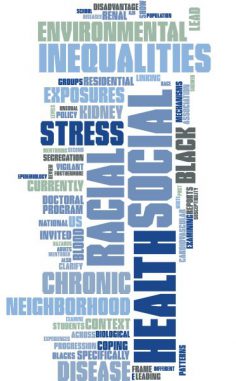Margaret Hicken
Research Associate Professor, Survey Research Center, Institute for Social Research
Research Associate Professor, Division of Nephrology, Department of Internal Medicine, Michigan Medicine
Faculty Associate, Population Studies Center, Institute for Social Research
Director, RacismLab
Director, Americans’ Changing Lives, Wave 6
Through my entire research program, I am committed to clarifying the social causes and biological mechanisms linking racial group membership to renal and cardiovascular disease inequalities. The major hallmark of my research is the integration of scientific knowledge from diverse disciplines, as this transdisciplinary approach to research allows for creative and innovative insights into the root causes and mechanisms of the seemingly intractable racial health inequalities. A significant portion of my research program falls at the intersection of sociology, geography, and environmental toxicology, examining the interrelated roles of racial residential segregation, neighborhood disadvantage, environmental hazards, and racial health inequalities.
Research Projects
Racial Inequalities in Health Throughout Adulthood: The Cumulative Impact of Neighborhood Chemical and Non-chemical Stressors on Epigenomic Pathways
(NIH/NIMHD 5R01MD013299) Racial inequalities in healthy aging have been well-documented. Compared to White Americans, Black Americans experience illness and death at early ages and show steeper age-related declines in health. Our neighborhoods, as the site of where we live, learn, play, and pray, may serve as a powerful source of these racial inequalities. Racial residential segregation (which is the sorting of different racial groups into different neighborhoods through historical and current discriminatory policies and practices) has resulted in a racially unequal American neighborhood landscape. Neighborhoods with mostly Black residents experience more poverty, civic and commercial disinvestment, and more exposure to environmental hazards compared to neighborhoods with mostly White residents. While more researchers are documenting the role of neighborhoods in health inequalities, we may actually be underestimating the true impact of neighborhood context, because we often focus on specific health outcomes, such as cardiovascular disease or diabetes. However, there are likely shared biological mechanisms within the body that drive many of these diseases – and one such mechanism may be changes to our genomic structure, called epigenomics. While our genes do not change, the environment can have an impact on whether our genes are actually “expressed”. We will determine whether the accumulation of adulthood lived experience in racially-segregated neighborhoods is related to epigenomic patterns called DNA methylation. We will also specifically determine whether the accumulation of adulthood exposure to neighborhood industrial air pollution and disadvantage together are related to these patterns of DNA methylation. Finally, we will determine whether the DNA methylation patterns we see are related to racial inequalities in healthy aging. We hypothesize that racially-segregation Black neighborhoods, with their greater levels of industrial air pollution and social disadvantage, will be related to the types of patterns in DNA methylation that have been shown to be related to chronic diseases in molecular studies. In fact, we further hypothesize that these patterns in DNA methylation will be related to racial inequalities in cognitive function and the number of chronic diseases one has had. Clarifying the role of neighborhood context in racial inequalities in healthy aging is critical, as neighborhoods are not naturally- occurring. They develop and change through policies and are amenable to intervention. Identifying the role of DNA methylation that likely underlies many chronic diseases, will clarify the importance of neighborhoods and point to potential effective interventions.
Racial inequalities in healthy aging have been well-documented. Compared to White Americans, Black Americans experience illness and death at early ages and show steeper age-related declines in health. Our neighborhoods, as the site of where we live, learn, play, and pray, may serve as a powerful source of these racial inequalities. Racial residential segregation (which is the sorting of different racial groups into different neighborhoods through historical and current discriminatory policies and practices) has resulted in a racially unequal American neighborhood landscape. Neighborhoods with mostly Black residents experience more poverty, civic and commercial disinvestment, and more exposure to environmental hazards compared to neighborhoods with mostly White residents. While more researchers are documenting the role of neighborhoods in health inequalities, we may actually be underestimating the true impact of neighborhood context, because we often focus on specific health outcomes, such as cardiovascular disease or diabetes. However, there are likely shared biological mechanisms within the body that drive many of these diseases – and one such mechanism may be changes to our genomic structure, called epigenomics. While our genes do not change, the environment can have an impact on whether our genes are actually “expressed”. We will determine whether the accumulation of adulthood lived experience in racially-segregated neighborhoods is related to epigenomic patterns called DNA methylation. We will also specifically determine whether the accumulation of adulthood exposure to neighborhood industrial air pollution and disadvantage together are related to these patterns of DNA methylation. Finally, we will determine whether the DNA methylation patterns we see are related to racial inequalities in healthy aging. We hypothesize that racially-segregation Black neighborhoods, with their greater levels of industrial air pollution and social disadvantage, will be related to the types of patterns in DNA methylation that have been shown to be related to chronic diseases in molecular studies. In fact, we further hypothesize that these patterns in DNA methylation will be related to racial inequalities in cognitive function and the number of chronic diseases one has had. Clarifying the role of neighborhood context in racial inequalities in healthy aging is critical, as neighborhoods are not naturally- occurring. They develop and change through policies and are amenable to intervention. Identifying the role of DNA methylation that likely underlies many chronic diseases, will clarify the importance of neighborhoods and point to potential effective interventions.
Racial inequalities in sleep deficiencies: The role of stress in the workplace
(R01 MD016244)
It has been well-documented that Black adults experience greater sleep difficulty and duration compared to White adults. Work-related stress, with its robust link to sleep deficiencies, may be a critical, but overlooked source of these racial inequalities in sleep. Through this research project, we will examine numerous types of work-related stress in relation to sleep and also clarify the possible biological link responsible for the impact that stress has on sleep.
DNA methylation in context: Racial inequities in social adversity and vulnerability to the health impact of air pollution
(NIH/NIA; R01 AG074887) Black-White inequities in healthy aging are well-known with Black adults experiencing greater risk of developing and earlier onset of chronic conditions such as cardiovascular disease (CVD), hypertension, and diabetes compared to White adults. Neighborhood context has emerged as a potentially powerful determinant of racial inequities in aging-related health conditions, including cognitive decline, and may be a key intervention site. Neighborhoods include both social and environmental exposures important for healthy aging. Evidence indicates stark racial inequities in exposure to segregated, under-resourced but over-surveilled and polluted neighborhoods. Pollution and aspects of social adversity are often correlated and may operate cumulatively to result in racial health inequities. Importantly, however, these chemical (i.e. pollution) and non-chemical (i.e., social adversity) stressors may act synergistically, whereby exposure to social adversity can heighten vulnerability to the deleterious health impact of even low levels of pollution. Yet, the environmental and social science literatures – even the environmental and social epidemiology literatures – are largely separate. There is a pressing need to integrate the study of these exposures given their likely cumulative and synergistic effects on racial health inequities in order to direct effective interventions and policies. In addition to the gaps in our knowledge about the combined impact of chemical and non-chemical stressors on racial inequities in healthy aging, there is a need to focus on outcomes that may serve as biological pathways to numerous diseases. Research on either pollution or social adversity has tended to focus on specific health outcomes. Focus on a single disease may underestimate the overall health impact of these racially unequal exposures. It is critical to clarify the shared biological mechanisms that underlie numerous chronic diseases to understand the full impact of pollution and social adversity on racial health inequities. A growing literature points to the importance of epigenetic factors, particularly DNA methylation, linking socioenvironmental context to health. Indeed, it may be that epigenetic processes are an important mechanism through which inequities in both air pollution and social adversity are embodied. Our objective is to identify underlying DNA methylation mechanisms linking neighborhood segregation and ambient and industrial air pollution and social adversity to measures of healthy aging. Clarifying the role of neighborhood in racial health inequities is critical, as neighborhoods are amenable to intervention. Identifying the role of DNA methylation patterns reflecting racial segregation, including chemical and non-chemical stressors, can point to specific disease etiologies and causal mechanisms effective interventions to eliminate racial inequities in healthy aging.
Black-White inequities in healthy aging are well-known with Black adults experiencing greater risk of developing and earlier onset of chronic conditions such as cardiovascular disease (CVD), hypertension, and diabetes compared to White adults. Neighborhood context has emerged as a potentially powerful determinant of racial inequities in aging-related health conditions, including cognitive decline, and may be a key intervention site. Neighborhoods include both social and environmental exposures important for healthy aging. Evidence indicates stark racial inequities in exposure to segregated, under-resourced but over-surveilled and polluted neighborhoods. Pollution and aspects of social adversity are often correlated and may operate cumulatively to result in racial health inequities. Importantly, however, these chemical (i.e. pollution) and non-chemical (i.e., social adversity) stressors may act synergistically, whereby exposure to social adversity can heighten vulnerability to the deleterious health impact of even low levels of pollution. Yet, the environmental and social science literatures – even the environmental and social epidemiology literatures – are largely separate. There is a pressing need to integrate the study of these exposures given their likely cumulative and synergistic effects on racial health inequities in order to direct effective interventions and policies. In addition to the gaps in our knowledge about the combined impact of chemical and non-chemical stressors on racial inequities in healthy aging, there is a need to focus on outcomes that may serve as biological pathways to numerous diseases. Research on either pollution or social adversity has tended to focus on specific health outcomes. Focus on a single disease may underestimate the overall health impact of these racially unequal exposures. It is critical to clarify the shared biological mechanisms that underlie numerous chronic diseases to understand the full impact of pollution and social adversity on racial health inequities. A growing literature points to the importance of epigenetic factors, particularly DNA methylation, linking socioenvironmental context to health. Indeed, it may be that epigenetic processes are an important mechanism through which inequities in both air pollution and social adversity are embodied. Our objective is to identify underlying DNA methylation mechanisms linking neighborhood segregation and ambient and industrial air pollution and social adversity to measures of healthy aging. Clarifying the role of neighborhood in racial health inequities is critical, as neighborhoods are amenable to intervention. Identifying the role of DNA methylation patterns reflecting racial segregation, including chemical and non-chemical stressors, can point to specific disease etiologies and causal mechanisms effective interventions to eliminate racial inequities in healthy aging.
Publications
- Hicken MT, Payne-Sturges D, McCoy E. Evaluating race in air pollution and health research: race, PM2.5 air pollution exposure, and mortality as a case study. Curr Environ Health Rep. 2023;10(1):1-11. doi:10.1007/s40572-023-00390-y
- Hicken MT, Dou J, Kershaw KN, Liu Y, Hajat A, Bakulski KM. Racial and ethnic residential segregation and monocyte dna methylation age acceleration. JAMA Netw Open. 2023;6(11):e2344722. doi:10.1001/jamanetworkopen.2023.44722
- Jang JB, Hicken MT, Mullins M, et al. Racial segregation and cognitive function among older adults in the united states: findings from the Reasons for Geographic and Racial Differences in Stroke Study. J Gerontol B Psychol Sci Soc Sci. 2022;77(6):1132-1143. doi:10.1093/geronb/gbab107
- Gee GC, Hicken MT. Structural racism: the rules and relations of inequity. Ethn Dis. 2021;31(Suppl 1):293-300. doi:10.18865/ed.31.S1.293
- Hicken MT, Miles L, Haile S, Esposito M. Linking history to contemporary state-sanctioned slow violence through cultural and structural racism. Ann Am Acad Pol Soc Sci. 2021;694(1):48-58. doi:10.1177/00027162211005690
- Lapedis CJ, Mariani LH, Jang BJ, Hodgin J, Hicken MT. Understanding the link between neighborhoods and kidney disease. Kidney360. 2020;1(8):845-854. doi:10.34067/kid.0001202019
- Saunders MR, Ricardo AC, Chen J,…Hicken MT, et al. Neighborhood socioeconomic status and risk of hospitalization in patients with chronic kidney disease: a chronic renal insufficiency cohort study. Medicine. 2020;99(28):e21028. doi:10.1097/MD.0000000000021028
- Duchowny KA, Hicken MT, Cawthon PM, Glymour MM, Clarke P. Life course trauma and muscle weakness in older adults by gender and race/ethnicity: results from the U.S. Health and Retirement Study. SSM Popul Health. 2020;11:100587. doi:10.1016/j.ssmph.2020.100587
- Noppert GA, Clarke P, Hicken MT, Wilson ML. Understanding the intersection of race and place: the case of tuberculosis in Michigan. BMC Public Health. 2019;19(1):1669. doi:10.1186/s12889-019-8036-y
- Schmitz LL, McCluney CL, Sonnega A, Hicken MT. Interpreting subjective and objective measures of job resources: the importance of sociodemographic context. Int J Environ Res Public Health. 2019;16(17):3058. doi:10.3390/ijerph16173058



